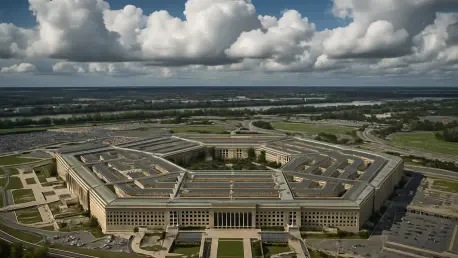What happens when the backbone of U.S. military technology—cloud systems handling sensitive operations—relies on code written by foreign nationals from a rival nation, sparking a firestorm in Washington? Defense Secretary Pete Hegseth issued a bold directive banning Chinese coders from working on Department of Defense (DoD) cloud systems, ripping open a debate about national security and exposing vulnerabilities in a practice once deemed manageable under strict supervision. This isn’t just a policy shift; it’s a wake-up call about who controls the digital keys to America’s defense infrastructure.
The importance of this ban cannot be overstated in an era where cyber threats loom larger than ever. With tensions between the U.S. and China simmering over technology and espionage, the Pentagon’s reliance on cloud systems for everything from logistics to warfighting data makes them a prime target. Hegseth’s move to eliminate Chinese involvement in coding for these systems signals a hard pivot toward safeguarding critical military tech from potential foreign interference. It’s a decision that resonates beyond the Pentagon, reflecting broader anxieties about how deeply globalized labor has infiltrated even the most secure corners of national defense.
A Startling Gap in Pentagon Security
The revelation that Chinese nationals were coding for DoD cloud systems under a so-called “digital escort” program has sent shockwaves through defense circles. For years, this initiative allowed foreign developers, including those based in China, to contribute to military tech under the watch of U.S. contractors. However, critics have long argued that the oversight was woefully inadequate, leaving open the possibility of malicious code or hidden backdoors being embedded in vital systems.
This wasn’t just a theoretical risk; it was a glaring blind spot in national security protocols. A recent investigation by ProPublica uncovered that even key DoD agencies, like the Defense Information Systems Agency, had limited knowledge of the program’s full scope or its inherent dangers. The lack of transparency about who was writing code for military infrastructure has fueled urgent calls for reform, culminating in Hegseth’s sweeping ban.
Geopolitical Stakes in the Cyber Arena
Amid escalating U.S.-China rivalry, the decision to bar Chinese coders from Pentagon projects carries profound geopolitical weight. Cyber warfare has emerged as a frontline battleground, with cloud systems serving as the nerve center for military operations. Allowing any foreign national—especially from a nation flagged for potential espionage—to access such sensitive tech has been labeled a reckless gamble by security hawks.
The ban aligns with growing public and governmental unease over foreign influence in critical sectors. Reports indicate that cyberattacks targeting U.S. infrastructure have spiked by over 60% in the past two years, with state-sponsored actors often implicated. Hegseth’s directive is seen as a necessary step to draw a firm line, prioritizing national security over the cost-saving allure of outsourced tech labor in a climate of heightened distrust.
Breaking Down the Ban’s Scope and Impact
The specifics of Hegseth’s order reveal a comprehensive crackdown on foreign involvement in DoD software development. The digital escort program, once touted as a controlled way to leverage global talent, has been dismantled for its failure to prevent security breaches. Critics, including Hegseth himself, pointed to the absence of robust checks, which could have allowed unauthorized access or tampering with military systems.
Major contractors like Microsoft, holder of the $9 billion Joint Warfighting Cloud Capability contract, have been thrust into the spotlight. The company swiftly ended its use of China-based teams for DoD projects and launched a no-cost audit to root out vulnerabilities. Beyond Microsoft, the directive mandates all DoD vendors to purge Chinese involvement from their workflows, marking a seismic shift in how the Pentagon engages with private tech partners.
This policy also exposes historical oversight failures that have lingered unchecked. Agencies admitted to lacking full visibility into the digital escort program’s operations, a gap that has alarmed lawmakers and security experts alike. The push now is for a complete overhaul of vendor accountability to ensure such risks are never repeated.
Expert Voices Weigh In on the Controversy
Defense Secretary Pete Hegseth has been unflinching in his critique, branding the digital escort program a betrayal of core “America first” values and a lapse in basic judgment. His sharp words underscore a broader frustration with past practices that prioritized efficiency over security. The urgency in his tone reflects a consensus among defense leaders that the status quo was untenable.
Adding to the discourse, Deven King, a spokesperson for the Defense Information Systems Agency, conceded that the DoD had significant blind spots in monitoring the initiative. An anonymous participant in the digital escort program, quoted in investigative reports, further revealed the lack of stringent rules to curb potential abuse. Meanwhile, Microsoft has committed to full cooperation with government demands, though Hegseth insists on independent audits to guarantee transparency, echoing expert warnings that past laxity could have already caused unseen damage.
Charting a Secure Path Forward for DoD Systems
Immediate action is underway to address the fallout from this security lapse, with Hegseth ordering dual investigations to detect any malware or hidden threats in DoD cloud systems. Microsoft’s internal audit, paired with a Pentagon-led independent review, aims to uncover whether harmful elements were introduced through the now-defunct program. Vendors face intense pressure to comply with findings and rectify any issues swiftly.
Beyond short-term fixes, the DoD is being urged to implement ironclad guidelines that ban foreign nationals from sensitive projects outright. Regular third-party audits of contractor practices are also on the table as a safeguard. A longer-term vision includes bolstering domestic tech talent to reduce reliance on global labor, ensuring that critical infrastructure remains in trusted hands.
Enhanced oversight mechanisms are another priority, with calls for a transparent framework to monitor contractor programs. The goal is to equip agencies with the tools and information needed to spot security gaps before they escalate into crises. These steps collectively aim to rebuild trust in the Pentagon’s partnerships with tech giants, placing security at the forefront of all future engagements.
Reflecting on a Pivotal Moment
Looking back, Hegseth’s decision to ban Chinese coders from Pentagon cloud systems stood as a defining moment in the ongoing struggle to protect U.S. military technology. The exposure of oversight failures in the digital escort program had forced a reckoning, prompting rigorous audits that sought to uncover any lingering threats. Microsoft and other vendors had come under unprecedented scrutiny, compelled to align with stricter security mandates.
Moving forward, the path was clear: the DoD needed to forge stronger policies that prioritized national interests over cost efficiencies. Investment in homegrown tech expertise emerged as a critical solution to prevent future vulnerabilities. Moreover, establishing a culture of accountability among contractors was deemed essential to ensure that such risks never resurface, setting a precedent for how military tech partnerships would evolve in the years ahead.









